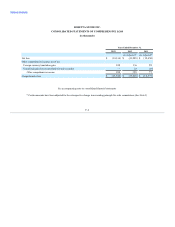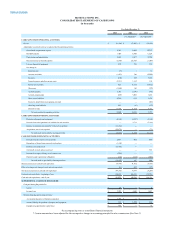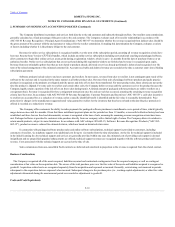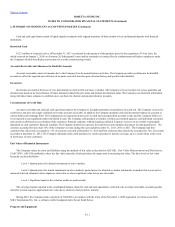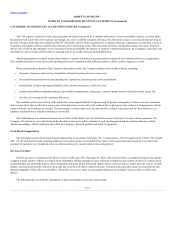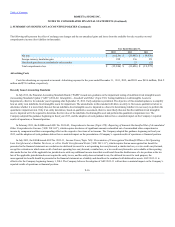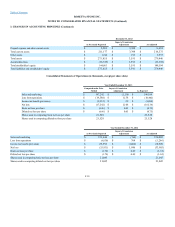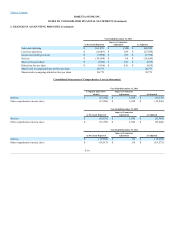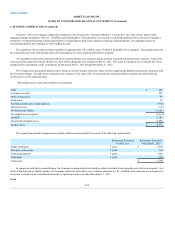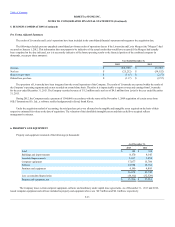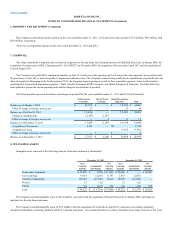Rosetta Stone 2013 Annual Report Download - page 78
Download and view the complete annual report
Please find page 78 of the 2013 Rosetta Stone annual report below. You can navigate through the pages in the report by either clicking on the pages listed below, or by using the keyword search tool below to find specific information within the annual report.
Table of Contents
ASC 740 requires a reduction of the carrying amounts of deferred tax assets by a valuation allowance if, based on available evidence, it is more likely
than not that such assets will not be realized. Accordingly, the need to establish valuation allowances for deferred tax assets is assessed periodically based on
the ASC 740 more-likely-than-not realization ("MLTN") threshold criterion. In the assessment for a valuation allowance, appropriate consideration is given to
all positive and negative evidence related to the realization of the deferred tax assets. This assessment considers, among other matters, the nature, frequency
and severity of current and cumulative losses, forecasts of future profitability, the duration of statutory carryforward periods, the Company's experience with
operating loss and tax credit carryforwards not expiring unused, tax credits, and tax planning alternatives.
Significant judgment is required to determine whether a valuation allowance is necessary and the amount of such valuation allowance, if appropriate.
The valuation allowance is reviewed at each reporting period and is maintained until sufficient positive evidence exists to support a reversal.
When assessing the realization of the Company's deferred tax assets, the Company considers all available evidence, including:
•the nature, frequency, and severity of cumulative financial reporting losses in recent years;
•the carryforward periods for the net operating loss, capital loss, and foreign tax credit carryforwards;
•predictability of future operating profitability of the character necessary to realize the asset;
•prudent and feasible tax planning strategies that would be implemented, if necessary, to protect against the loss of the deferred tax assets; and
•the effect of reversing taxable temporary differences.
The evaluation of the recoverability of the deferred tax assets requires that the Company weigh all positive and negative evidence to reach a conclusion
that it is more likely than not that all or some portion of the deferred tax assets will not be realized. The weight given to the evidence is commensurate with the
extent to which it can be objectively verified. The more negative evidence that exists, the more positive evidence is necessary and the more difficult it is to
support a conclusion that a valuation allowance is not needed.
The establishment of a valuation allowance has no effect on the ability to use the deferred tax assets in the future to reduce cash tax payments. The
Company will continue to assess the likelihood that the deferred tax assets will be realizable at each reporting period and the valuation allowance will be
adjusted accordingly, which could materially affect the Company's financial position and results of operations.
The Company accounts for its stock-based compensation in accordance ASC topic 718, ("ASC 718"). Under
ASC 718, all stock-based awards, including employee stock option grants, are recorded at fair value as of the grant date and recognized as expense in the
statement of operations on a straight-line basis over the requisite service period, which is the vesting period.
Net loss per share is computed under the provisions of ASC topic 260, . Basic loss per share is computed using net loss and the
weighted average number of shares of common stock outstanding. Diluted earnings per share reflect the weighted average number of shares of common stock
outstanding plus any potentially dilutive shares outstanding during the period. Potentially dilutive shares consist of shares issuable upon the exercise of stock
options, restricted stock awards, restricted stock units and conversion of shares of preferred stock. Common stock equivalent shares are excluded from the
diluted computation if their effect is anti-dilutive. When there is a net loss, there is a presumption that there are no dilutive shares as these would be anti-
dilutive.
The following table sets forth the computation of basic and diluted net loss per common share:
F-14


